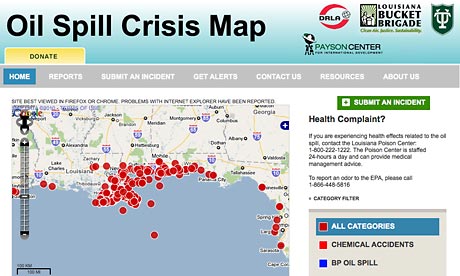Ushahidi Launches Simplified Crisis-Mapping Service
Crowdmap allows users to report incidents within minutes without installing platform on server or paying for host

The Ushahidi platform used to map the Gulf oil spill
The online crisis-mapping platform Ushahidi has launched a simplified service, a move co-founder Ory Okolloh said is "a landmark" in its short history. Ushahidi's Crowdmap allows users to begin crowdsourcing reports within minutes, eliminating the need to for technological knowledge to install the service on a server or funds to pay for domain rights. "This is huge. It's a landmark," Okolloh said. "This has the potential to take us to the next level in terms of scale, like Blogger did for blogging – Crowdmap has the potential to do that for mapping. "One of the challenges behind Ushahidi is that it's still difficult to use, you still need some tech knowledge that not everyone has, you needed design skills also, and you needed your own server. "A lot of the groups wanting to use Ushahidi didn't have a techy person to assist or couldn't afford a host. The idea is to make the tool more accessible, like with WordPress and WordPress.com." The platform, built primarily by only two people, has been in development since the beginning of this year. The launch marks Ushahidi's intention to move with user demand, Okolloh said. "A lot of our development is driven by user feedback – I'd say about 90%, we try not to build tools that are cool, but to build tools that actually work for people." It took a matter of hours after its launch for Crowdmap to be overwhelmed by demand, and Okolloh admitted that the service's popularity may create problems. She said that the company may have to invest in new servers. Ushahidi – Swahili for "witness" – was born out of the ethnic violence in Kenya in 2008 that claimed more than 1,100 lives and displaced about 300,000 people. After a close-fought election, incumbent Kenyan president Mwai Kibaki was announced as re-elected on 30 December 2007. Opposition leader Raila Odinga contested the result, claiming Kibaki's count had been inflated by 300,000 votes. Widespread protests sparked ethnic violence and two months of national chaos ensued, leading to a media blackout. Okolloh took to her Kenyan Pundit blog, asking fellow citizens to share information before proposing the idea of mapping reports. The first version of Ushahidi was launched after a weekend of development work. http://www.guardian.co.uk/technology/2010/aug/11/ushahidi-crowdmap-crisis-mapping
